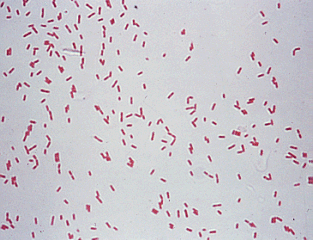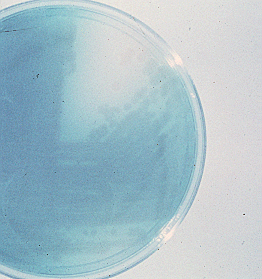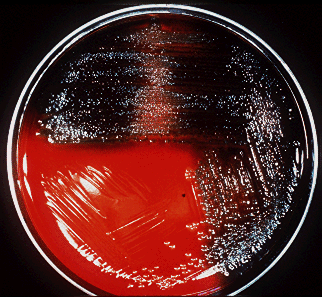(under the microscope) |  |
Pseudomonads are motile, Gram-negative rods that utilize glucose oxidatively. Members of this genus are classified into five groups based on ribosomal RNA homology. These bacteria are clinically important because they are resistant to most antibiotics and they are capable of surviving in conditions that few other organisms can tolerate. They also produce a slime layer that is resistant to phagocytosis. Pseudomonas is often encountered in hospital and clinical work because it is a major cause of hospital acquired (nosocomial) infections. Its main targets are immunocompromised individuals, burn victims, and individuals on respirators or with indwelling catheters. Additionally, these pathogens colonize the lungs of cystic fibrosis patients, increasing the mortality rate of individuals with the disease. Infection can occur at many sites and can lead to urinary tract infections, sepsis, pneumonia, pharyngitis, and a lot of other problems. Rarely will you find Pseudomonas as a cause of infection in healthy individuals. Its non-invasive nature limits its pathogenic capabilities.
Pseudomonas aeruginosa is the most frequently isolated non-fermenter in the laboratory. It has several features that distinguish it from other species of Pseudomonas:
 The basis of this organisms pathogenicity involves several toxins and chemicals which the bacterium secretes
upon infection. The lipopolysaccharide layer helps the cell adhere to host tissues and prevents leukocytes
from ingesting and lysing the organism. Lipases and exotoxins then procede to destroy host cell tissue which
then leads to the complications associated with infection.
P. aeruginosa prefers to inhabit moist environments but it can survive in a medium as deficient as
distilled water. It will also grow on just about any laboratory medium and is beta-hemolytic on blood agar.
Treatment of Pseudomonas infection consists of a combination of two antibiotics: for example
an anti-pseudomonal penicillin and an aminoglycoside. The best way to reduce the spread of P. aeruginosa
in the hospital is to use good aseptic technique on hospital instruments and when in contact with patients.
The basis of this organisms pathogenicity involves several toxins and chemicals which the bacterium secretes
upon infection. The lipopolysaccharide layer helps the cell adhere to host tissues and prevents leukocytes
from ingesting and lysing the organism. Lipases and exotoxins then procede to destroy host cell tissue which
then leads to the complications associated with infection.
P. aeruginosa prefers to inhabit moist environments but it can survive in a medium as deficient as
distilled water. It will also grow on just about any laboratory medium and is beta-hemolytic on blood agar.
Treatment of Pseudomonas infection consists of a combination of two antibiotics: for example
an anti-pseudomonal penicillin and an aminoglycoside. The best way to reduce the spread of P. aeruginosa
in the hospital is to use good aseptic technique on hospital instruments and when in contact with patients.
(under the microscope) |  |
Pseudomonas cepacia is an opportunistic pathogen of cystic fibrosis patients. It also shows substantially greater antibiotic resistance than its relative, P. aeruginosa. However, P. cepacia can be distinguished from other Pseudomonas species because it is lysine positive.
Although not of the same genus, Stenotrophomonas maltophila (formerly known as Xanthomonas maltophila) is very similar to the Pseudomonads. This motile bacterium is a cause of nosocomal infections in immunocompromised patients. S. maltophila also harbors significant resistance to many antibiotics considered effective for treating Pseudomonas infections. However, most strains of the bacterium are susceptible to trimethoprim or sulfamethoxazole. S. maltophila can also be distinguished from Pseudomonas species by the lysine and DNAse tests for which it is positive.



